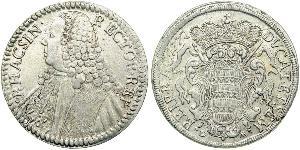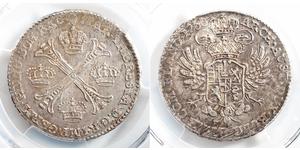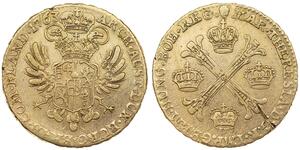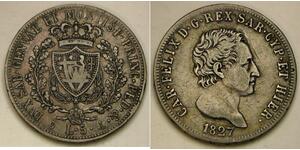1 Ducat Kingdom of the Netherlands (1815 - ) Gold
Netherlands. Dutch Type Gold Knight Ducat.
Mint Year: 1849
Denomination: Gold Knight Ducat
Reference: Friedberg 161 (Russia), Bitkin 35, Uzd. Fig 16.2,, KM-83.2.
Material: Pure Gold (.986)
Diameter: 21mm
Weight: 3.45gm
Obverse: Knight standing right in armour, holding sword which rests on shoulder and a bundle of arrows. Date (18-49) split in fields.
Legend: (privy mark: sword) CONCORDIA RES PARVAE CRESSCUNT (privy mark: caduceus)
Expanded Legend: CONCORDIA RESPARVAE CRESCUNT
Translated: "Through concord little things grow (Union is strength)!"
Reverse: Legend in five lines inside ornate square. Fields around decorated with floral ornaments.
Legend: MO : ORD : PROVIN : FOEDER : BELG . AD LEG . IMP .
Expanded: "MOneta ORDinum PROVINciarum FOEDERatorum AD BELGicarum LEGem IMPerii"
Translated: "Coin of government of the provincial federation of Belgium Conforming with the law of the Imperial."
Minted in Holland beginning in the 17th century to fuel its extraordinary tenure as the world’s foremost commercial trader, the Netherlands one ducat gold coin offers both strong visual appeal and a scarcity value that could command a healthy premium in the years to come.
The first Netherlands trade ducat was issued in 1487 under Phillip the Fair and a coin very similar to the one depicted above has been minted more or less continuously from the early 1600s on. The net fine weight of 3.5 grams gold never changed to the modern era. The trade ducat is minted as a gold bullion coin even today. Only the Venetian ducat has enjoyed greater longevity.
The obverse of the famed ducat coin depicts a knight holding a bundle of arrows signifying the unity of the six northern provinces under the 1579 Union of Utrecht — a declaration of independence from Spain. The motto Concordia Res Parvae Crescunt translates to “the union makes small things grow.” The legend on the reverse translates to "money of the provinces of the United Netherlands according to the law of the empire."
View all coins in the group
(1537 X 746 pixels, file size: ~224K)
Posted by: anonymous 2018-12-10
1928, Netherlands, Queen Wilhelmina. Gold Ducat Coin. (Lustre AU-UNC!) 3.49gm! Mint Year: 1928 Mint Place: Utrecht Condition: Lustre AU-UNC! Denomination: Gold Knight Ducat Reference: KM-83.1. (Netherlands Section) / KM-T1 (Netherlands East Indies Section). Material: Gold (.983) - 0.110 ...
(1500 X 743 pixels, file size: ~168K)
Posted by: anonymous 2018-03-15
Niederlande-Königreich. Wilhelmina I. 1890-1948. Dukat 1928, Utrecht. K.M. 83.1, Friedberg 352.GOLD. Fast Stempelglanz
(900 X 457 pixels, file size: ~125K)
Posted by: anonymous 2016-11-29
Niederlande-Königreich, Wilhelmina I. Dukat 1908, Utrecht. Friedberg 352, Schulman 762. GOLD. Prachtexemplar. Stempelglanz
(1200 X 594 pixels, file size: ~176K)
Posted by: anonymous 2016-12-08
NIEDERLANDE Königreich der Niederlande Wilhelmina 1890-1948. Dukat 1928. 3.49 g. Schulman 779. Schl. 200. Fr. 352. Vorzüglich / Extremely fine.
(900 X 457 pixels, file size: ~125K)
Posted by: anonymous 2016-12-03
Russland, Nikolaus I. Niederländischer Dukat 1849, St. Petersburg. Münzzeichen Schwert und Fackel. Friedberg 344, Bitkin 35. GOLD. Fast Stempelglanz
(800 X 405 pixels, file size: ~100K)
Posted by: anonymous 2016-03-19
MONETY ZAGRANICZNE - ROSJA /RUSSIA/ - Rosyjskie naśladownictwa monet niderlandzkich. dukat 1849, złoto 3.47 g, Fr. 161, Bitkin 35 - GRADE: II+
|
1/2 Kronenthaler Netherlands Silver
group has 9 coins / 8 prices
⇑
5 Lira Italian city-states Silver Charles Felix of Sardinia
group has 18 coins / 16 prices
⇑

-500-250-8zd_AAEBDZ8AAAEjcMrAPfNS.jpg)
-300-150-Uy6siWwInzYAAAFnmgLz7pa5.jpg)
-300-150-w3IKqUpYPgcAAAFij4Ss7yuv.jpg)
-300-150-1XMKX9ISoIkAAAFYg4Lqnq66.jpg)
-300-150-EJIKX9ISN7oAAAFYxt2Dj99u.jpg)
-300-150-BcsKX9ISbMkAAAFYMgg668Jb.jpg)
-300-150-0wYKX9IS9wYAAAFTGjprNo13.jpg)















